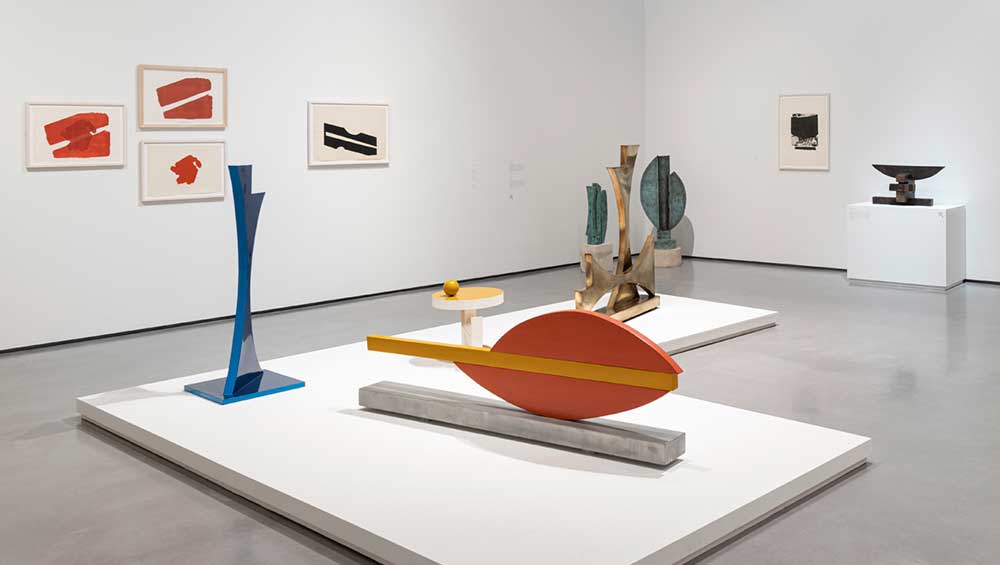
Kim Lim: Space, Rhythm & Light, installation view, The Hepworth Wakefield, 25 November 2023 – 2 June 2024.
The Hepworth Wakefield
25 November 2023 – 2 June 2024
by DAVID TRIGG
In 1954, Kim Lim (1936-1997) arrived in London from Singapore to study sculpture at Saint Martin’s School of Art. However, her penchant for abstraction riled tutor Anthony Caro and, on the advice of Elisabeth Frink, she transferred to the Slade School of Fine Art, where her experiments with abstract forms were encouraged. Though she went on to make a significant contribution to postwar art in Britain, her work has been marginalised in the histories of British sculpture since her death. This comprehensive survey of Lim’s work at the Hepworth Wakefield is the artist’s first major museum show since 1999 and reveals her extraordinary versatility over four decades; from early assemblages and geometric abstractions to inky screenprints, delicate lithographs and elegant stone and marble carvings inspired by natural forms.
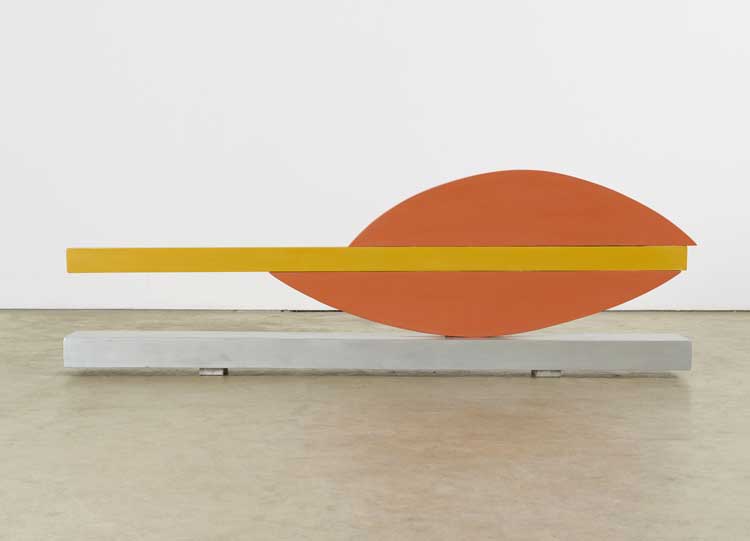
Kim Lim, Candy, 1965. © Estate of Kim Lim. All Rights Reserved, DACS 2023. Arts Council Collection, Southbank Centre, London. Photograph courtesy Arts Council Collection, Southbank Centre, London.
Born in Singapore to Chinese parents, Lim grew up in the Malaysian peninsula before returning to Singapore to finish her schooling. As an art student in London, she focused on carving and printmaking, becoming technically adept at both. One of the show’s earliest works, Kiss (1959), is a semi-abstract stone sculpture in which two carved heads of unequal size are poised, ready to embrace, yet never touch. Perhaps intended as an homage to Constantin Brâncuși’s carved plaster sculpture of the same name (1907-08), this and other early works are displayed alongside formally similar screenprints such as Chrysalis Green (1960) and Head (1960), demonstrating Lim’s enduring fascination with translating abstract forms between two and three dimensions. Indeed, Lim identified as a printmaker as much as a sculptor, noting that the two mediums were of equal importance to her.
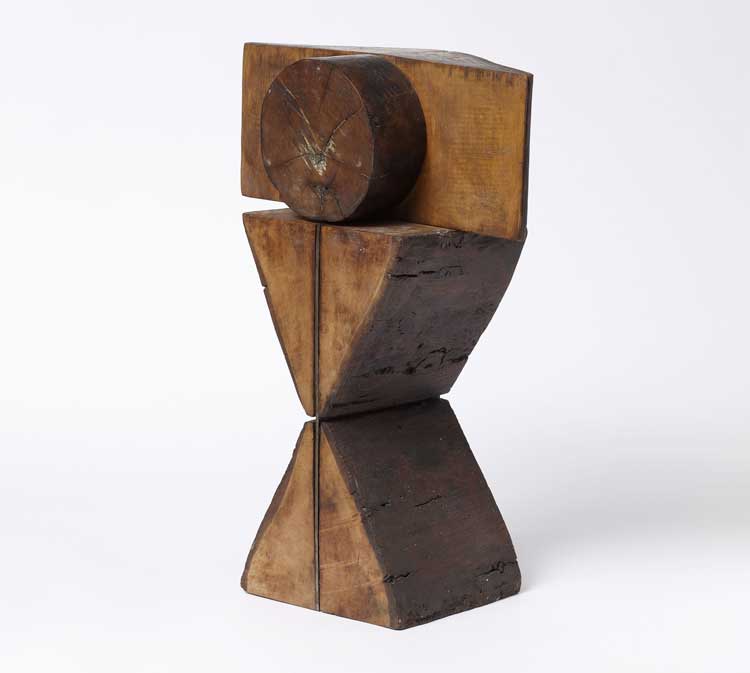
Kim Lim, Chess Piece 1, 1960. © Estate of Kim Lim. All Rights Reserved, DACS 2023. Photo: Mark Dalton.
After graduating in 1960, Lim experimented with new materials, notably chunks of scrap wood, which she would combine in modular configurations. Although signs of carving are evident in works such as Samurai (1961), most of these assemblages involve minimal intervention, incorporating found shapes to explore relationships between abstract forms while emphasising the wood’s rough-hewn and time-worn textures. Titles such as Chess Piece I (1960) and Caryatid (1961) reflect Lim’s interests, the latter referring to the carved female figures used as supporting columns or pillars in ancient Greek architecture. Her fascination with ancient cultures took her all over the world and her taste for the formal simplicity of Archaic motifs, Cycladic art, Shang bronzes and Han sculpture is reflected across her non-figurative work.
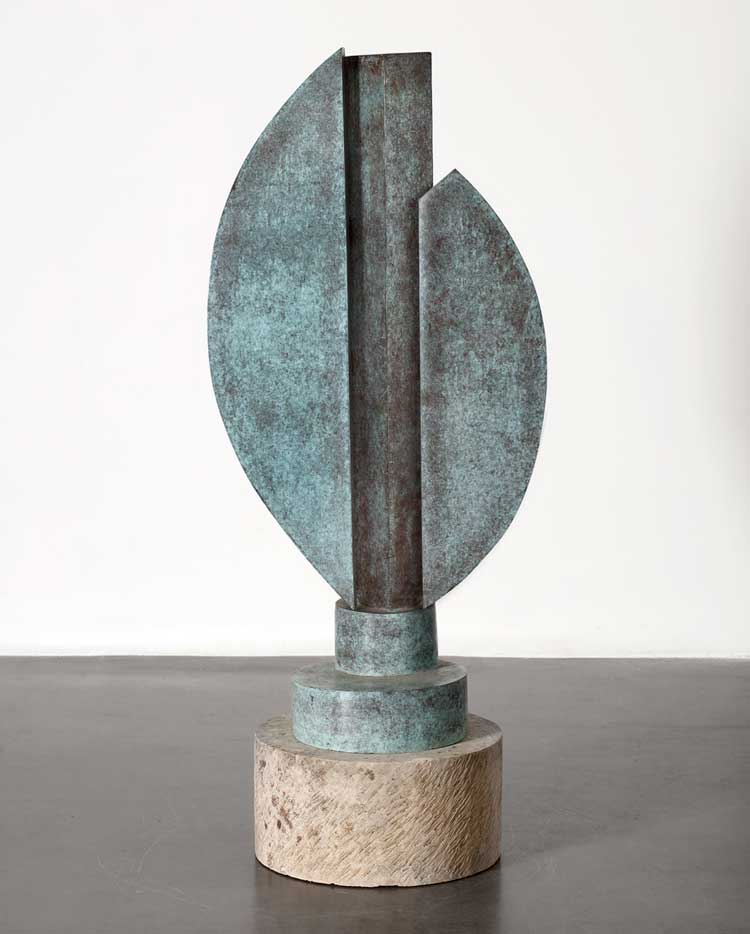
Kim Lim, Pegasus, 1962. © Estate of Kim Lim. All Rights Reserved, DACS 2023. Photo: Mark Dalton.
Lim’s abstract sculptures of the 1960s and 70s in wood and bronze are characterised by graceful geometries, as in the hemispherical forms of Pegasus (1962), which typify her ability to transform elementary shapes into refined sculptural forms. This small bronze sits atop a diminutive stone plinth, its title perhaps referring to the winged horse of Greek mythology; each of its “wings” is hinged, meaning they can move and potentially be reconfigured. This intriguing aspect of the work, not apparent from photographs, prefigured Lim’s multi-partite Intervals, Link and Interstices series (1973-77), which can be arranged in endless configurations.
.jpg)
Kim Lim working on Twice, 1966. ©
Estate of Kim Lim. All Rights Reserved, DACS. Photo: Jorge Lewinski. © The Lewinski Archive at Chatsworth. All Rights Reserved 2023 / Bridgeman Images.
By the mid-60s, Lim was working on a larger scale and becoming bolder in her use of colour. A cluster of works from this period in brass and painted wood sit closely together on a white platform, approximating a photograph of Lim’s studio around the time of her first solo show at London’s Axiom Gallery in 1966. Their elegant lines and graceful curves balance with hard angles and flat planes while exuding an inherent playfulness. It is a tight hang, but deliberately so, allowing the works to dialogue with one another. Some, such as Table (1964) and Twice (1966), evoke children’s building blocks or puzzle pieces (Lim had become a mother in 1962 and her second son was born the following year).
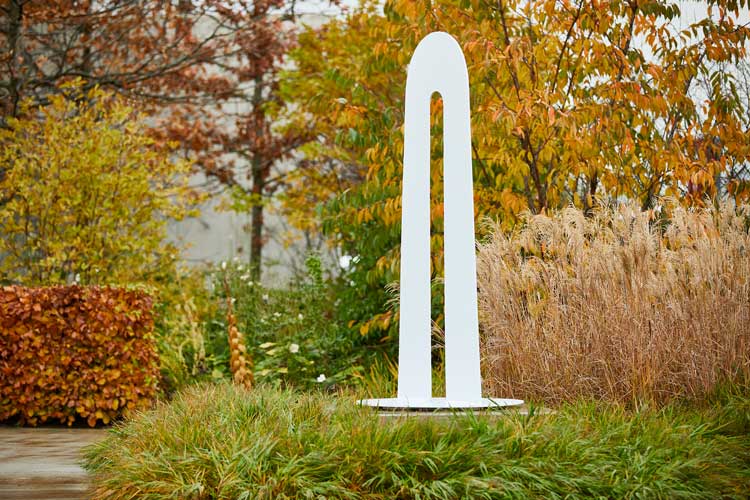
Kim Lim, Day, 1966. © Estate of Kim Lim. All Rights Reserved, DACS 2023. The Hepworth Wakefield (Wakefield Council Permanent Art Collection). Photo: Nick Singleton.
Eschewing signs of the artist’s hand, these slick, industrial looking sculptures were formally in tune with the new “pure” style of minimalism espoused by Britain’s New Generation sculptors, including: David Annesley; Michael Bolus; Phillip King; William Tucker; Lim’s husband, William Turnbull; and Caro, her former tutor. Though not counted as part of this group, Lim occasionally showed alongside these artists, for example in the 1966 exhibition Sculpture in the Open Air in Battersea Park, which also featured British art heavyweights including Henry Moore, Frink and Barbara Hepworth. Here, Lim exhibited her arresting steel sculpture Day (1966), a tall and slender elliptical archway painted white that now has a permanent home in the Hepworth Wakefield Garden.
Although Lim enjoyed considerable recognition in her lifetime, she regularly had to contend with sexism and racism in the British art world; her achievements were often overshadowed by those of her spouse, and she was regularly defined by her nationality. Nevertheless, she remained committed to her artistic vision even if, at times, it left her isolated. For instance, she turned down an invitation from Rasheed Araeen to participate in the pivotal 1989 exhibition The Other Story: Afro-Asian Artists in Postwar Britain at the Hayward Gallery, stating that she did not want to “other herself”. For Lim, her work was the most important thing; race and gender were “givens”, while her geographical origins were not something to which she wished to draw attention.
,-1972.jpg)
Kim Lim, Intervals (Blue), 1972. © Estate of Kim Lim. All Rights Reserved, DACS 2023. Photo: Mark Dalton.
In the 70s, Lim continued to probe the interaction between two and three dimensions. Her rigidly structured Ladder prints of the early 70s contain repeating, rhythmical forms that appear in sculptures such as the spine-like Intervals I (1973), which playfully leans against the gallery wall. Lim once said that her main concerns in making art were “not so much for volume, mass and weight, but rather with form, space, rhythm and light”. This is evident in much of her work at the Hepworth Wakefield, but especially so in a series of “sculptures in paper”, in which different patterns of straight lines are incised into sheets of heavy card. Each stencil-like image is hung slightly away from the wall so that they cast shadows, emphasising their physicality as objects.
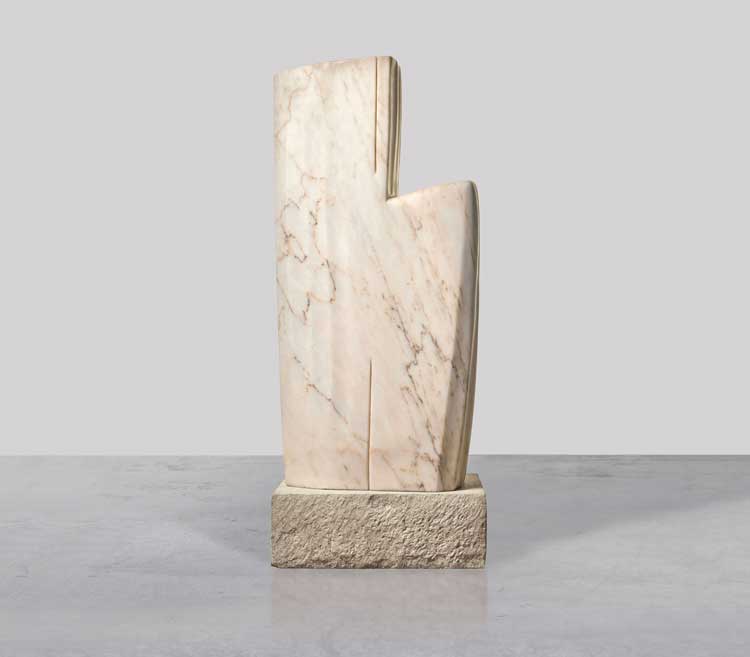
Kim Lim, Kudah, 1989. © Estate of Kim Lim. All Rights Reserved, DACS 2023. Photograph courtesy The Estate of Kim Lim.
From 1980, Lim turned her attention to stone-carving with an increased emphasis on the subtleties of surface, texture and line, while continuing to make prints and drawings. This sudden shift was provoked by seeing her old and new work displayed together at her first survey show at the Roundhouse Gallery in London, and she worked on totemic columns and modular floor-based forms in Portland stone, Hopton Wood stone, rose aurora marble, granite and slate until her death. As in earlier works, we see a bold use of line with carvings such as Column (1984) and Wind-Stone (1992), whose rhythmic, striated grooves suggest the action of water over centuries. The organic lines are repeated in a selection of busy aquatints and lithographs, though the relationship between these and the adjacent sculptures is less evident.
The cohesiveness of Lim’s oeuvre is striking, and this exhibition showcases her approach with care and sensitivity. It is an opportunity to ponder why, despite being included in important surveys of modern British sculpture during her lifetime, she has not since received the critical recognition she so evidently deserves. Further, it is a fitting testament to a strong and single-minded artist who refused to align herself with any particular movement and pursued her singular path without compromise.